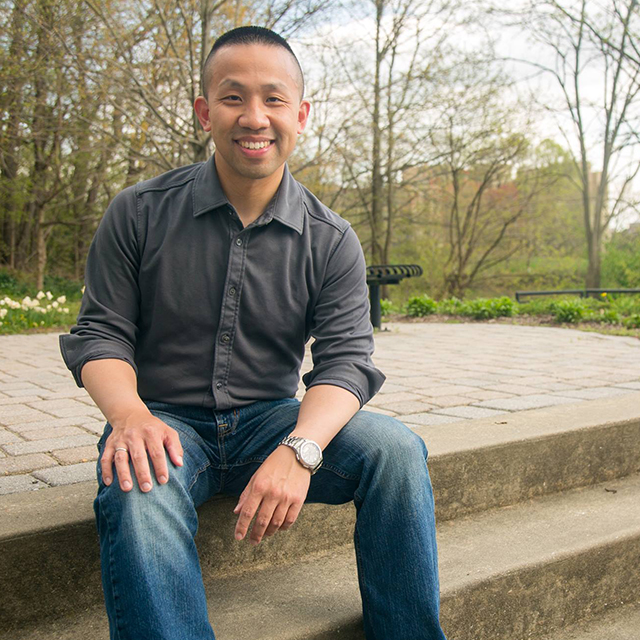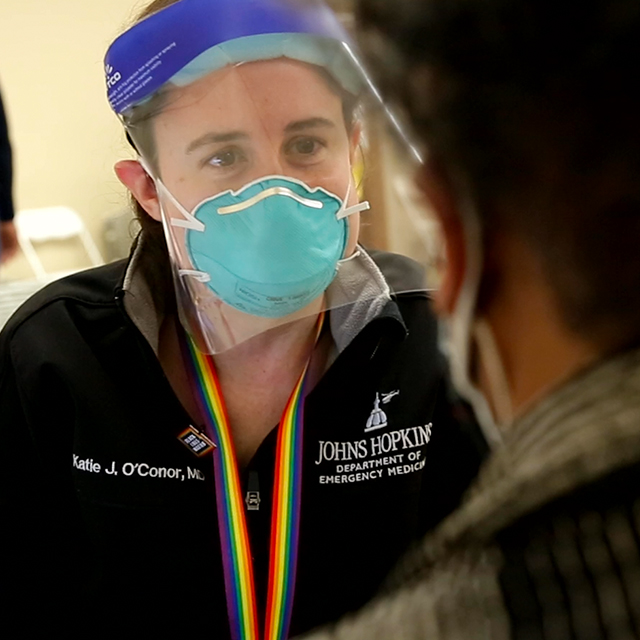Joy Curbean-Johnson has some COVID-19 vaccine advice for her fellow Johns Hopkins employees.
“Get the shot,” she says. “This pandemic is real.”
Curbean-Johnson, who works in human resources with the Johns Hopkins Children’s Center, hesitated for months before getting vaccinated against COVID-19, despite a dangerous bout with the infection in January. On Aug. 6, she got her second dose of the Pfizer-manufactured vaccine.
“I was scared,” she says when asked why she didn’t get the shots sooner. After she had COVID-19, she explains, she mistakenly feared that the vaccine could trigger another infection. (Click here to learn more about COVID-19 myths and facts.)
“I just kept saying I wasn’t ready to get it. It felt like it [was released] too soon,” she says. “We have all these diseases that there’s no vaccine for. Then COVID-19 showed up and a year later there was a vaccine for it? It seemed too fast.
“But I’m so glad I got vaccinated. It’s what we all need.”
Her ordeal with the disease illustrates why.
Early this year, before vaccinations were widely available, Curbean-Johnson and three family members contracted the virus that causes COVID-19. First, her adult daughter felt sluggish. Then, her husband, who lost his best friend to COVID-19 a month before, started feeling bad. Both tested positive and quarantined. Within a day or two, Curbean-Johnson tested positive too, as did her elderly mother, who lives with them. Curbean-Johnson’s mother spent two weeks in the hospital and two more in rehabilitation.
“We had all those symptoms you hear about,” says Curbean-Johnson. “Cough, fever, aches, chills, couldn’t smell anything. We were so sick. And with this virus, when you think you should be getting better, you get worse. It’s bad.”
Gradually, Curbean-Johnson and her family recovered. Happy to have the COVID-19 episode behind her, Curbean-Johnson returned to work in mid-February, about a month after she tested positive for the virus. She was free of COVID-19 symptoms, but she developed a mysterious pain in her left foot.
“I didn’t know why my foot was killing me,” she says. “It didn’t make sense.”
She figured she must’ve injured herself while bowling. Curbean-Johnson and her husband are devoted bowlers and spent a few hours at the lanes the evening before her foot started hurting.
They were masked and kept distance from other bowlers, but neither had received the COVID-19 vaccine.
After a few days, the pain in three toes on her left foot became debilitating. On Valentine’s Day, a Sunday, she went to a walk-in clinic near her home in hopes of getting some answers and relief.
“[Clinic staff] sent me to the hospital immediately,” she says. “They told me I had ‘COVID toes.’ I said, ‘What? I’ve never heard of that!’”
Her toes were purple.
“Like, literally, purple,” she says. “Not cute.”
When emergency physicians at the hospital told Curbean-Johnson that the pain in her foot was the result of the COVID-19 infection she had a month prior, she was skeptical. The miserable fever and aches were gone. She had her sense of smell back. Her cough had mostly vanished.
“I thought, ‘Oh, here we go again. It’s another excuse to call something COVID related. I’m so tired of hearing about COVID,’” she says.
Curbean-Johnson didn’t realize that blood clots are among the many dangerous problems that COVID-19 can cause. Clots in the lungs, brain, heart or legs can result in a deadly heart attack or stroke. They also can cut off blood flow to limbs, which can lead to gangrene and amputation. A vascular surgeon told her she needed emergency surgery to restore blood flow or risk losing her toes.
“It was one of the scariest times in my life,” Curbean-Johnson says. “And one of the loneliest.” COVID-19 restrictions meant her family members and friends could not visit her.In a haze from pain medication, she called her colleague, Zina Brown, late one night during her hospital stay.
“We prayed and prayed together,” Curbean-Johnson says through tears. “I’m just so grateful for the people I work with.”
By the summer months, as more Americans got vaccinated, Curbean-Johnson heard a news report that the vast majority of people who were hospitalized or dying of COVID-19 had not received the vaccine.
“That’s what did it for me,” she says. “That’s when I decided to get vaccinated. I should have gotten it a long time ago. But I’m glad I have it now.”
When Curbean-Johnson finally received the first dose of the Pfizer vaccine at the Walgreens pharmacy near her home, she says her mild side effects were nothing compared to the sickness and fear she experienced due to COVID-19.
Now, she and her husband are bowling again, and they even qualified for the finals of a summerlong tournament. The entire family is vaccinated.
Curbean-Johnson is grateful to her co-workers and managers, particularly Kris Lukish and Misty Turner, for helping her through the toughest days of her family’s illness.
“The dinners they sent us, the prayers, everything they did while we were sick — they just helped us keep our momentum to get better,” Curbean-Johnson says. “I call them my HR family. They’re not blood, but they’re still family.”


